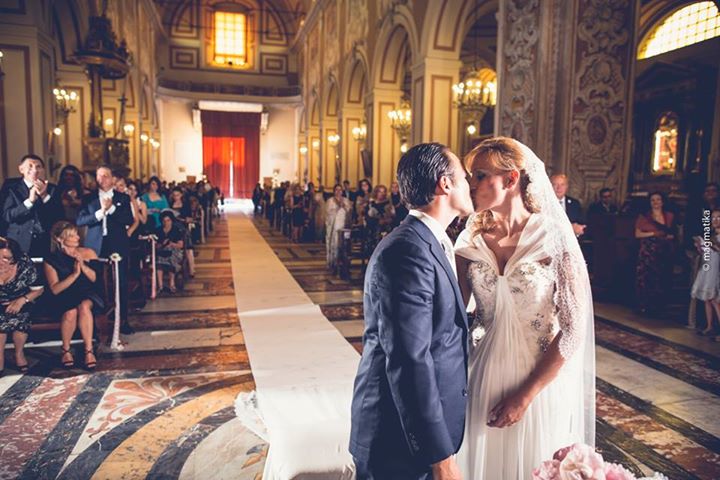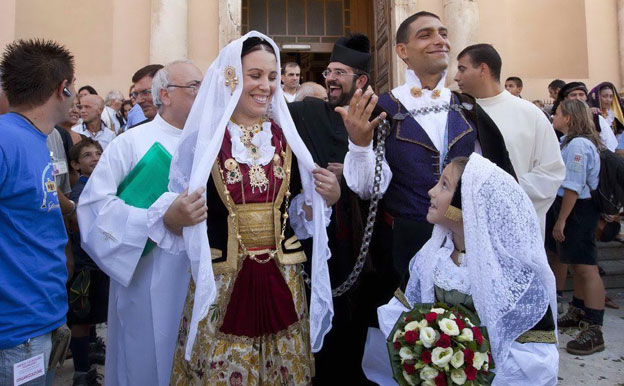Your wedding day is one of the most important days in your life and should therefore be one of the most memorable. So couples wanting to create that special memory are choosing to tie the knot abroad, with weddings taking place on secluded beaches or on top of mountains, or, in the case of people picking Italy for their wedding destination, amid enchanting scenery and historic architecture.
Picture a warm afternoon in Sorrento, the perfume from flowering verbena hangs in the air as a gentle breeze dances between the arched pillars surrounding The Cloister of San Francesco: one of Italy’s most popular wedding venues for foreigners. A mandolin plays softly as the groom waits nervously for his bride to join him and…
Who wouldn’t want that memory? In fact I’ll let you borrow it for a while, as it’s actually one of mine from 2009. This had me thinking, if you want to get married in Italy, why not adopt a few of the Italian traditions to add to your experience. Many are regional and some are no longer practiced, but nevertheless here’s a handful for you to consider.

The Bride
On her wedding day, the bride is expected to wear a garter. This is a tradition that dates back to the 14th century, when it was thought that owning a piece of the bridal trousseau would bring luck. After the ceremony, the bride would remove the garter and it would be torn into pieces for the guests to keep. In some Italian regions, it is the groom's job to remove and throw it to his guests; if, unfortunately, the bride is found not to wearing a garter, her right shoe is then removed and thrown.
The tradition of 'the groom can’t see the bride' on the wedding day is practiced all over the world, however, in certain Italian regions even the bride can’t look at herself. It is considered bad luck if she sees herself in the mirror before she is dressed in her bridal finery and then only after she’s removed a glove or a shoe.
Traditionally to bring good luck, the bride would spend the night before her wedding with her parents at their home. In some regions of Italy, it is also considered to bring ill-luck to the couple’s joining if the bride wears any gold jewellery on her wedding day other than her wedding ring.
The Groom
In Italy, traditionally, it is the groom’s job to supply the bridal bouquet. This is considered to be his final gift to his girlfriend before she becomes his wife. The bride may choose the floral arrangement she wants, but it is the groom who must pay the bill and make sure it is delivered to his intended.
In some Northern provinces, the groom must wait with the bouquet outside the church for his bride to arrive and hand it to her before taking his place in readiness for the marriage.

In the old days, similar to the bride’s garter tradition, before the guests settled down for the wedding breakfast, the groom’s tie was removed and cut into pieces that were distributed between the male guests who, in turn, exchanged this for a small cash donation for the newly-wed couple.
In some parts of Italy the groom is expected to walk his bride from her parents' home to the church, followed by the whole wedding party.
The Dress
Everyone expects to see a bride in white, however, it hasn’t always been the colour of choice. In Tuscany, for example, a traditional bride would wear a black dress with a white hat. In Venice, it was the custom for the bride to walk to church wearing her second-best wedding dress; her much finer bridal gown being saved for after the church ceremony for her first dance as a wife.
The bridal veil dates back to ancient Rome when marriages were arranged by the family. To prevent the bride and groom from seeing each other before they married and running the risk that one of them may not go ahead with the proposed union, the bride’s face would be completely covered.
In southern Italy, traditionally, the veil should be as long as the young couple’s love for each other, usually one-metre in length for each year they have been engaged.

Other Traditions
Even the day you choose to marry must be considered carefully. Sunday is still considered the best day to marry for luck, fertility and prosperity. It used to be bad luck to marry on a Friday as it was first thought that this is the day evil spirits were created. Tuesday (Martedì) used to be thought of as a bad day for a marriage: Marte comes from the God of War, and it was believed that couples who married on this day would spend each day of their lives together fighting. For a widow remarrying, Saturday was considered the best day for the union to take place.
Following the wedding, in some regions, the bride and groom would break a glass vase and the fragments would be counted, the amount of broken pieces would indicate the amount of happy years ahead.
 Another tradition that takes place in many other countries is the bomboniere with confetti, wedding favours with the traditional sugared almonds given to the guests. Traditionally, these almond treats in Italy were thrown to the bride and groom as they got out of the church, but they have now been replaced by rose petals or environmentally-friendly coriandoli (tissue paper confetti - to know more about the confusing language issues regarding the words 'confetti' and 'coriandoli' read our dedicated article here).
Another tradition that takes place in many other countries is the bomboniere with confetti, wedding favours with the traditional sugared almonds given to the guests. Traditionally, these almond treats in Italy were thrown to the bride and groom as they got out of the church, but they have now been replaced by rose petals or environmentally-friendly coriandoli (tissue paper confetti - to know more about the confusing language issues regarding the words 'confetti' and 'coriandoli' read our dedicated article here).
For a wedding, the almonds traditionally must be coated in white sugar and the amount given must always be an odd number, because the union of marriage is of two people so the amount must never be divisible by two.
With the wedding over, the couple enjoy their 'luna di miele', honeymoon. This is a tradition and word that dates back to ancient Rome when newly-weds would spend an entire phase of the moon after their marriage eating a portion of honey at every mealtime.
Today, in modern Italy, many of these traditions have been forgotten, or even replaced with new customs, but should you choose to adopt any of them for you big day in Italy, may you have a memory that will stay with you forever.













